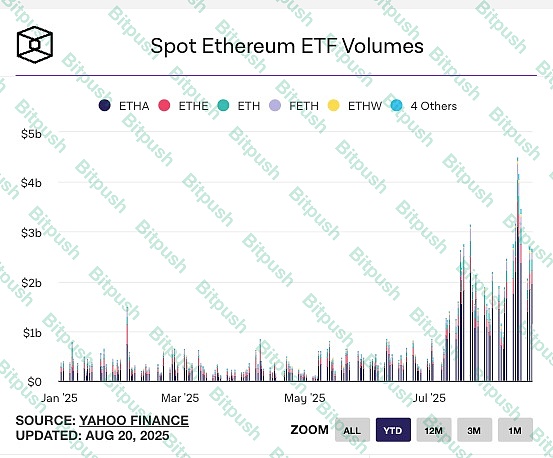
Ethereum (ETH) has significantly outperformed Bitcoin (BTC) in the past few weeks.
According to the latest research report released by JPMorgan, Wall Street analysts attribute this phenomenon to four core factors – optimization of ETF structure, increase in corporate finance departments, easing of regulatory attitudes, and the potential relaxation of future pledge functions.
These factors not only explain Ethereum’s recent strength, but also indicate that it may have greater room for upward in the future.
1. Market background: the dual driving force of policy and capital flow
In July, the US Congress passed the GENIUS Act stablecoin bill, bringing unprecedented institutional benefits to the crypto market.Then, the Ethereum spot ETF attracted record-breaking momentum in July$5.4 billion inflow, almost the same as the inflow of funds from Bitcoin ETFs.

However, in August, Bitcoin ETF showed a small outflow of funds, while Ethereum ETF continued the trend of net inflow of funds.This differentiation of capital flows has become the direct fuse for Ethereum to achieve excess performance against Bitcoin.
At the same time, the market is still waiting for the “Crypto Market Structure Act” to be voted for in September.Investors generally expect this will be another major turning point similar to stablecoin legislation.Under the dual role of policy and market expectations, Ethereum’s position in the capital market has risen rapidly.
2. Analysis of four major factors: Why does Ethereum outperform Bitcoin?
JPMorgan analyst Nikolaos Panigirtzoglou and his team clearly stated in the report that Ethereum’s strength comes from the following four core drivers:
1. Potential opening of staking function
At present, a major feature of the Ethereum ecosystem is the PoS (Proof of Stake) staking mechanism.Users need at least 32 ETH to run the verification nodes themselves, but for most institutional investors and retail investors, this threshold is relatively high.
If the U.S. Securities Regulatory Commission (SEC) finally approves the spot Ethereum ETF to allow pledge, then the fund manager can directly create additional returns for the holders without requiring investors to run the nodes themselves.This means that spot ETH ETFs are not only a price tracking tool, but will also be upgraded to a “passive investment product with profits.”
This is essentially different from Bitcoin’s spot ETFs: Bitcoin itself does not have a native return mechanism, and Ethereum ETFs may come with “interest” in the future, which obviously increases its market attractiveness.
2. Increase and application of corporate finance department
JPMorgan said there are currently appointments10 listed companiesInclude Ethereum in the balance sheet, accounting for approximately the total circulation2.3%.
What is more noteworthy is that some companies not only “buy and hold”, but further participate in the ecosystem:
Run the verification node: Directly obtain pledge income.
Adopt liquid staking or DeFi strategy: invest ETH into derivative agreements to earn additional income.
This means that Ethereum gradually evolves from a “speculative asset” to“Enterprise Sustainable Asset Allocation Tool”.And this trend is exactly what Bitcoin has not yet fully realized.
The intervention of the corporate finance department represents a longer-term and stable capital pool entry, and also enhances the market’s valuation anchoring of Ethereum.
3. Regulators ease their attitude towards liquid staking tokens
Previously, SECLido,Rocket PoolThe compliance of liquid staking tokens (LSTs) is always controversial, and the market is worried that these tokens will be recognized as securities, which will affect the participation of large-scale institutions.
However, the latest situation is that the SEC has given clarification at the staff level that “may not be considered as a security”.Although the legislation has not yet been formally legislated, this statement has greatly alleviated the concerns of the institutions.
Against this background, institutional funds that were originally on the verge of compliance may enter Ethereum pledge and related derivative markets faster and larger.
4. Optimization of ETF redemption mechanism: Approved in physical redemption
The SEC recently approved the physical redemption mechanism for spot Bitcoin and Ethereum ETFs.This means that when institutional investors redeem their ETF share, they no longer have to go through the cumbersome process of “selling the ETF first to exchange it for cash”, but can directly withdraw equal amounts of Bitcoin or Ethereum.

This mechanism brings three major benefits:
-
Improve efficiency: Save time and cost.
-
Enhance liquidity: ETFs are directly linked to the spot market.
-
Reduce the throwing pressure: Avoid triggering market selling when large-scale redemptions.
For Bitcoin and Ethereum, this system is also good, but because Ethereum accounts for a relatively low proportion of corporate and institutional holdings, it means that there is greater room for growth in the future and the marginal effect is more significant.
3. Future Outlook: Has Ethereum’s potential surpassed Bitcoin?
JPMorgan pointed out in its report that although Bitcoin is still the leader in the “store of value” of the crypto market, Ethereum has a broader space for growth:
-
ETF adoption (ETF popularity): The funding scale of ETH ETF is still lower than that of BTC, but with the relaxation of the pledge function, it is expected to attract more long-term funds.
-
Corporate adoption (corporate popularity): Bitcoin has been held by a large number of enterprises and institutions, while Ethereum is still in its infancy, and there is huge room for incremental growth in the future.
-
DeFi and application ecosystem: Ethereum is not only a digital asset, but also carries applications such as decentralized finance (DeFi), NFT, stablecoins, AI+on-chain computing, and so on-chain computing, so it has a richer usage scenario.
In other words, Bitcoin is more like “digital gold”, while Ethereum is evolving into “the infrastructure of the digital economy.”
4. Conclusion
JPMorgan’s analysis reveals a key logic: Ethereum’s strength is not driven by short-term speculation, but is based onPolicies, structural optimization, institutional adoption and potential benefitsAbove the superposition effect of the four major factors.
With the further improvement of the ETF mechanism, the continuous increase in the holdings of the corporate finance department, and the possible future policy confirmation of the SEC, Ethereum is expected to gradually narrow or even surpass Bitcoin’s advantages in the future market structure.
For investors, this trend is not only a signal of capital flow, but also a turning point in the entire crypto market from a “single store of value” to a “multi-dimensional application ecosystem”.
In a new chapter in the history of cryptocurrency, Bitcoin may still be “digital gold”, but Ethereum is rapidly growing into the “heart of the digital economy.”






